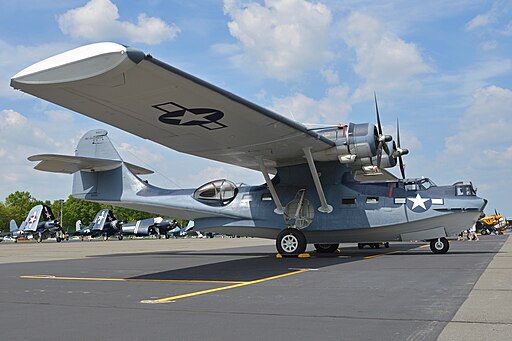As the evening skies darkened over the vast expanse of the Pacific during the Second World War, an unusual breed of warbirds emerged from the shadows. Unlike the shiny metal bodies of most aircraft, these birds were painted pitch black. Known as the “Black Cats,” these PBY Catalina flying boats would soon etch their legacy as mere nocturnal hunters and heroes of the Pacific Theater.
The Birth of a Legend
In the initial skirmishes of the Pacific War, the Allies didn’t take long to pick up on something crucial: the night was an ally in its own right. The cover of darkness was, in essence, a shield from the enemy’s watchful and often deadly gaze. However, a specialized fleet was needed to harness the nocturnal battlefield’s full potential. Thus, the PBY Catalina – a reconnaissance and anti-submarine aircraft – transformed into a blackened night warrior.
These were not ordinary missions. Flying without the safety net of daylight, these squadrons sought to disrupt enemy supply lines, perform surprise attacks, and gather critical intelligence under the shroud of night.
Challenges and Triumphs in the Darkened Sky
The very audacity of the Black Cats’ operations demanded exemplary skill and courage. Flying at perilously low altitudes to avoid radar detection, they’d sweep silently over enemy ships, dropping bombs or torpedoes before the vessels could scramble their defenses. It was a deadly game of cat and mouse, played in almost total darkness.
One of the most riveting tales is the story of a Black Cat crew who, after spotting a Japanese convoy, relayed its position and kept track of its movements throughout the night. Dodging enemy fire and even engaging in a daring low-level bombing run, the crew managed to delay the convoy’s progress, allowing American naval forces to intercept and decimate it by morning.
Beyond Combat: The Humanitarian Side
But it wasn’t all about destruction. PBYs, inherently versatile, also played a significant role in search and rescue missions. Many downed Allied airmen owed their lives to the vigilant eyes of Black Cat crews who, amid the vast and treacherous Pacific waters, would spot and retrieve them, often under enemy fire.
This dual role – as both aggressor and savior – underlines the unique character of the Black Cat missions. While many squadrons focused solely on combat, the Black Cats blended aggression with compassion, reflecting the broader complexities of war.
Legacy of the Black Cats
The legacy of the Black Cats extends beyond their tactical achievements. These men, with their blackened birds, demonstrated unparalleled audacity and innovation. In an era where technology was still nascent and night warfare was in its infancy, they proved that ingenuity and courage could bridge the gap.
Today, as we look back at the vast tapestry of World War II, the Black Cat squadrons stand out not just as a testament to American tactical prowess but as a beacon of the human spirit’s resilience and adaptability.
To those brave souls who ventured into the heart of darkness, navigating the treacherous skies and seas of the Pacific, we owe a profound debt of gratitude. In military history, the Black Cats shine – not as mere footnotes but as daring protagonists of the Pacific night.
For more insights into the PBY-5A Catalina and other important military aircraft, visit Aces In Action. Here, you’ll find an amazing piece of artwork by Craig Tinder titled “Moonlit Nemesis” that illustrates the tribute to the pilots and crews who flew the perilous bombing and sea rescue missions with the PBY Catalina. The limited edition canvas print even includes a relic from a PBY based in the Atlantic Theater serving in Morocco and the Caribbean searching for German U-boats.
Moonlit Nemesis – PBY-5A Catalina Aviation Art by Artist Craig Tinder
28 August 1942 – VP-92’s PBY Catalina BuNo. 7295 embarked on a daring night mission from Guantanamo Bay, escorting a convoy heading for the Windward Passage between Cuba and Haiti. Close to midnight, the PBY spotted the German U-boat, U-94, under hazy moonlight. The submarine, about to fire a torpedo, initiated a crash-dive upon detecting the aircraft. The Catalina released four depth charges, disabling U-94’s diving panes. The Canadian corvette HMCS Oakville then rammed and sunk the U-boat, resulting in 19 casualties. U-94 had previously completed nine war patrols and sunk 26 ships.
To purchase or see similar items, visit here.Commissioned by Museums, Treasured by Collectors





Share:
B-17’s in Popular Culture: From Sky-Borne Legends to Iconic Imagery
Firepower from Above, the story behind "Wicked Wanda"